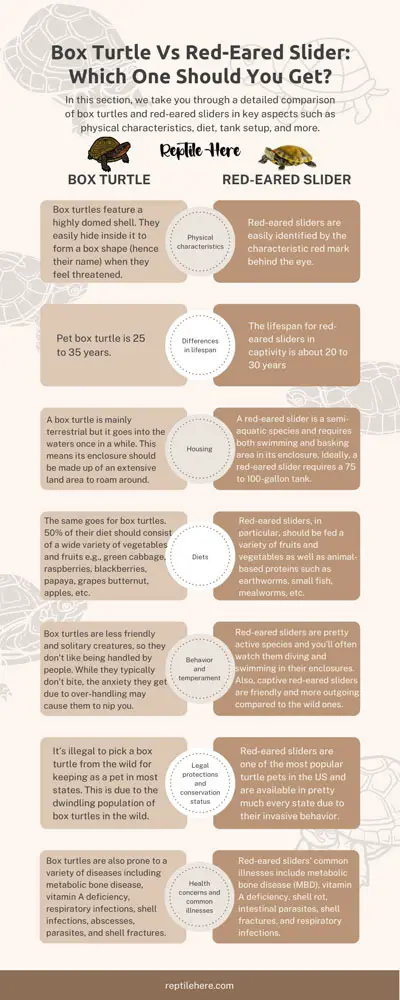Box Turtle Vs Red Eared Slider: Which One To Get?
If you’re tied between a box turtle or a red-eared slider for a pet, this guide will help you out. Choosing a turtle species for a pet is always a daunting task as you have to consider a handful of factors including housing, lifespan, diet, and overall care and maintenance costs, etc. So, how do box turtles and red-eared sliders compare as pets?
Box turtle vs red-eared slider key differences includes size, shell colorations and patterns, and cost. The two species also have subtle differences in terms of behavior and temperament and life expectancy. However, both turtles are omnivores and easy to care for.
This article will delve deeper into the comparison between these two species of turtles alongside various aspects. We’ll do a side-by-side comparison of the two species to give you a clear picture of each of them and help you easily decide which one to get.
Box Turtle Vs Red Eared Slider Comparison Table:
Contents
| Red-Eared Slider (Trachemys scripta elegans) | Box Turtle (Terrapene Carolina) | |
| Size | 5 to 12 inches | 4 to 7 inches |
| Diet | Omnivore | Omnivore |
| Temperament | Friendly | More shy than aggressive |
| Care Level | Beginner | Beginner |
| Cost | $10 to $25 | $100 to $500 |
| Life expectancy | 20 to 30 years | 25-35 years |
Box turtle Vs red-eared slider: Which one should you get?
In this section, we take you through a detailed comparison of box turtles and red-eared sliders in key aspects such as physical characteristics, diet, tank setup, and more.

Physical characteristics
Box turtles feature a highly domed shell. They easily hide inside it to form a box shape (hence their name) when they feel threatened. Their plastron usually has a dark brown appearance. They also feature a coloration of yellow and orange splotches.
Red-eared sliders are easily identified by the characteristic red mark behind the eye. They have a yellow plastron with dark blotchy markings in addition to yellow marginal scutes. Similar to box turtles, the slider’s markings become less visible with age.

Differences in lifespan
The lifespan for red-eared sliders in captivity is about 20 to 30 years while that of a pet box turtle is 25 to 35 years. The box turtle seems to be slightly ahead of its counterpart in terms of life expectancy.

Nevertheless, both types of turtles will live for exceptionally long periods of time and require long-life commitments. But keep in mind that the level of care you give your turtle significantly affects its longevity.
Housing
A box turtle is mainly terrestrial but it goes into the waters once in a while. This means its enclosure should be made up of an extensive land area to roam around.
In addition, you should provide it with a water bowl where it can walk into or even completely soak in. Note that a box turtle can be housed in an indoor enclosure or outdoor pen.
The ideal box turtle habitat should include a spacious tank to provide plenty of space for roaming, digging, and exploring.

It should also be equipped with substrate (optional), UV light, heat lamp, non-toxic live plants for box turtles, and plenty of hiding spots.
A red-eared slider is a semi-aquatic species and requires both swimming and basking area in its enclosure. Ideally, a red-eared slider requires a 75 to 100-gallon tank.
It should also feature a comfortable basking area, powerful filtration system, heat source, and UVB light.
If you want, you can house your slider in an outdoor pond in warmer climate areas. In this case, you should properly secure the pond to keep out predators.
Diet
When it comes to diet, the two turtle species are omnivorous and require both plant and animal matter for a balanced diet.
Red-eared sliders, in particular, should be fed a variety of fruits and vegetables as well as animal-based proteins such as earthworms, small fish, mealworms, etc. You can also feed them commercial turtle pellets.
For a balanced diet, fruits and veggies should make up 50% of their diet while the rest should go to animal proteins (i.e., 25% prey food items and 25% turtle pellets).

Box turtles should eat at least 50% fruit and vegetables like green cabbage, raspberries, blackberries, papaya, grapes, butternut, apples, etc.
And the other 50% should be made up of prey items such as crickets, earthworms, mealworms, caterpillars, snails, etc., and commercial box turtle pellets (25%).
However, note that young box and red-eared slider turtles tend to eat more insects and small amphibians while the older ones are more herbivorous.
Behavior and temperament
Box turtles are less friendly and solitary creatures, so they don’t like being handled by people. While they typically don’t bite, the anxiety they get due to over-handling may cause them to nip you.
Once they get used to their new home, however, they may learn to recognize you and beg for food or even follow you from inside their enclosure.

Red-eared sliders are pretty active species and you’ll often watch them diving and swimming in their enclosures. Also, captive red-eared sliders are friendly and more outgoing compared to the wild ones.
They don’t have the instinct to scratch or bite you in case you touch it. However, sometimes your pet may feel more nervous when you handle it and retract into its shell or try to nip you. That’s why always advise you to minimize handling.
Legal protections and conservation status
It’s illegal to pick a box turtle from the wild for keeping as a pet in most states. This is due to the dwindling population of box turtles in the wild.
As such, you’d want to confirm with your local regulation on box turtle ownership, including the number you’re allowed to keep.
Red-eared sliders are one of the most popular turtle pets in the US and are available in pretty much every state due to their invasive behavior.
However, there are a few states that have banned red-eared sliders as pets because they carry salmonella, so you should research your local wildlife laws to find out if it’s legal to keep one.
Health concerns and common illnesses
Red-eared sliders’ common illnesses include metabolic bone disease (MBD), vitamin A deficiency, shell rot, intestinal parasites, shell fractures, and respiratory infections.
Most of these diseases are attributed to poor animal husbandry, including poor living conditions and feeding your turtle a low-quality diet

Box turtles are also prone to a variety of diseases including metabolic bone disease, vitamin A deficiency, respiratory infections, shell infections, abscesses, parasites, and shell fractures.
Just like sliders, these box turtle health problems are also brought about by poor animal husbandry.
Box turtle vs red eared slider for home with kids
If you’re looking for a pet turtle for a home with kids, then you’ll also need to consider which one will be compatible with your kids.
Box turtles are generally solitary creatures and don’t like being handled or petted too much. This makes it a less favorable choice for young kids.

The red-eared slider is less aggressive and rarely scratches or bites you when touched. This means it will make a favorite pet turtle among young kids.
Even then, you should keep the handling of your slider pet to a minimum as turtles don’t like too much petting as your dog or cat does.
Plus, turtles are carriers of salmonella bacteria which can make your kids sick if they touch them.
FAQs:
Malayan box turtles have more specialized needs than red-eared sliders, including specific humidity and temperature requirements. Red-eared sliders are hardier than Malayan box turtles and can withstand a wide humidity and temperature range and are generally easier to care for. The Malayan box turtles are a better option for experienced turtle owners while RES turtles are ideal for absolute beginners.
Technically, the red-eared sliders can eat box turtle foods. Both turtle species are omnivores and require the same type of diet of plant and animal materials to stay healthy. However, we suggest sticking to food specially formulated for your red-eared sliders to help meet their nutritional requirements.
Box turtles and red-eared sliders cannot live together. The two species have completely different habitats, and their recommended water depths and temperatures are completely different. The red-eared sliders are also quite territorial and will likely take advantage of the box turtles’ poor swimming ability and small size to attack them. If you plan to get both species of turtles, you should keep them in separate enclosures.
Final Verdict
Before you decide to get a box turtle or a red-eared slider, you should first understand the special needs and requirements of each species and ensure that you’ll be ready to commit and get the resources you need to meet those needs. This will ensure you can take good care of your new pet so it can live a happy and healthy life.
In this box turtle vs red-eared slider guide, we’ve discussed everything you need to know before choosing any of these turtle species for a pet including the diet, behavior and temperament, housing, common illnesses, and legal protections. We hope that this info will help you easily decide whether to get a box turtle or a red-eared slider for a pet.



Need to know the value of a roughly 12” box turtle. Amazon killed him driving into our property not that there is a value to us but can you assign a value to a turtle of that size and age. We’re pretty pissed. He was male. Thanks